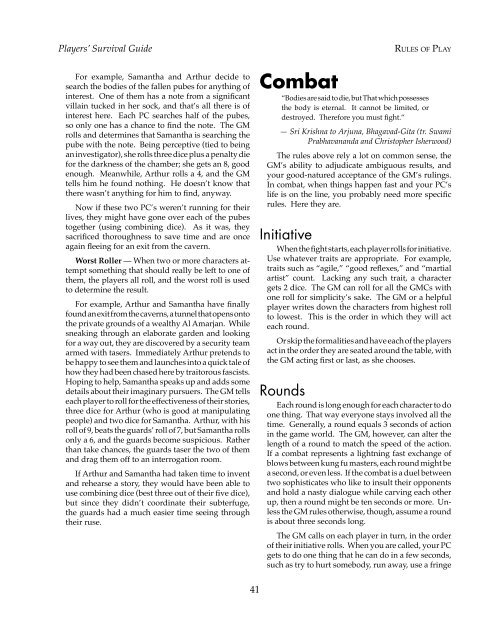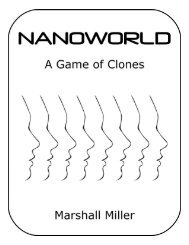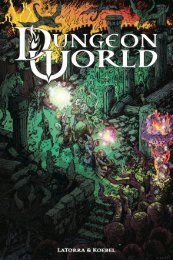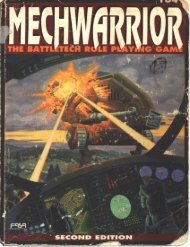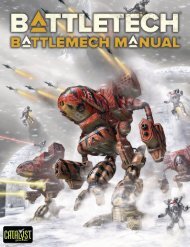Over_the_Edge_Players'_Survival_Guide
Player's guide to Over the Edge rpg
Player's guide to Over the Edge rpg
You also want an ePaper? Increase the reach of your titles
YUMPU automatically turns print PDFs into web optimized ePapers that Google loves.
Players’ <strong>Survival</strong> <strong>Guide</strong><br />
For example, Samantha and Arthur decide to<br />
search <strong>the</strong> bodies of <strong>the</strong> fallen pubes for anything of<br />
interest. One of <strong>the</strong>m has a note from a significant<br />
villain tucked in her sock, and that’s all <strong>the</strong>re is of<br />
interest here. Each PC searches half of <strong>the</strong> pubes,<br />
so only one has a chance to find <strong>the</strong> note. The GM<br />
rolls and determines that Samantha is searching <strong>the</strong><br />
pube with <strong>the</strong> note. Being perceptive (tied to being<br />
an investigator), she rolls three dice plus a penalty die<br />
for <strong>the</strong> darkness of <strong>the</strong> chamber; she gets an 8, good<br />
enough. Meanwhile, Arthur rolls a 4, and <strong>the</strong> GM<br />
tells him he found nothing. He doesn’t know that<br />
<strong>the</strong>re wasn’t anything for him to find, anyway.<br />
Now if <strong>the</strong>se two PC’s weren’t running for <strong>the</strong>ir<br />
lives, <strong>the</strong>y might have gone over each of <strong>the</strong> pubes<br />
toge<strong>the</strong>r (using combining dice). As it was, <strong>the</strong>y<br />
sacrificed thoroughness to save time and are once<br />
again fleeing for an exit from <strong>the</strong> cavern.<br />
Worst Roller — When two or more characters attempt<br />
something that should really be left to one of<br />
<strong>the</strong>m, <strong>the</strong> players all roll, and <strong>the</strong> worst roll is used<br />
to determine <strong>the</strong> result.<br />
For example, Arthur and Samantha have finally<br />
found an exit from <strong>the</strong> caverns, a tunnel that opens onto<br />
<strong>the</strong> private grounds of a wealthy Al Amarjan. While<br />
sneaking through an elaborate garden and looking<br />
for a way out, <strong>the</strong>y are discovered by a security team<br />
armed with tasers. Immediately Arthur pretends to<br />
be happy to see <strong>the</strong>m and launches into a quick tale of<br />
how <strong>the</strong>y had been chased here by traitorous fascists.<br />
Hoping to help, Samantha speaks up and adds some<br />
details about <strong>the</strong>ir imaginary pursuers. The GM tells<br />
each player to roll for <strong>the</strong> effectiveness of <strong>the</strong>ir stories,<br />
three dice for Arthur (who is good at manipulating<br />
people) and two dice for Samantha. Arthur, with his<br />
roll of 9, beats <strong>the</strong> guards’ roll of 7, but Samantha rolls<br />
only a 6, and <strong>the</strong> guards become suspicious. Ra<strong>the</strong>r<br />
than take chances, <strong>the</strong> guards taser <strong>the</strong> two of <strong>the</strong>m<br />
and drag <strong>the</strong>m off to an interrogation room.<br />
If Arthur and Samantha had taken time to invent<br />
and rehearse a story, <strong>the</strong>y would have been able to<br />
use combining dice (best three out of <strong>the</strong>ir five dice),<br />
but since <strong>the</strong>y didn’t coordinate <strong>the</strong>ir subterfuge,<br />
<strong>the</strong> guards had a much easier time seeing through<br />
<strong>the</strong>ir ruse.<br />
RULES OF PLAY<br />
Combat<br />
“Bodies are said to die, but That which possesses<br />
<strong>the</strong> body is eternal. It cannot be limited, or<br />
destroyed. Therefore you must fight.”<br />
— Sri Krishna to Arjuna, Bhagavad-Gita (tr. Swami<br />
Prabhavananda and Christopher Isherwood)<br />
The rules above rely a lot on common sense, <strong>the</strong><br />
GM’s ability to adjudicate ambiguous results, and<br />
your good-natured acceptance of <strong>the</strong> GM’s rulings.<br />
In combat, when things happen fast and your PC’s<br />
life is on <strong>the</strong> line, you probably need more specific<br />
rules. Here <strong>the</strong>y are.<br />
Initiative<br />
When <strong>the</strong> fight starts, each player rolls for initiative.<br />
Use whatever traits are appropriate. For example,<br />
traits such as “agile,” “good reflexes,” and “martial<br />
artist” count. Lacking any such trait, a character<br />
gets 2 dice. The GM can roll for all <strong>the</strong> GMCs with<br />
one roll for simplicity’s sake. The GM or a helpful<br />
player writes down <strong>the</strong> characters from highest roll<br />
to lowest. This is <strong>the</strong> order in which <strong>the</strong>y will act<br />
each round.<br />
Or skip <strong>the</strong> formalities and have each of <strong>the</strong> players<br />
act in <strong>the</strong> order <strong>the</strong>y are seated around <strong>the</strong> table, with<br />
<strong>the</strong> GM acting first or last, as she chooses.<br />
Rounds<br />
Each round is long enough for each character to do<br />
one thing. That way everyone stays involved all <strong>the</strong><br />
time. Generally, a round equals 3 seconds of action<br />
in <strong>the</strong> game world. The GM, however, can alter <strong>the</strong><br />
length of a round to match <strong>the</strong> speed of <strong>the</strong> action.<br />
If a combat represents a lightning fast exchange of<br />
blows between kung fu masters, each round might be<br />
a second, or even less. If <strong>the</strong> combat is a duel between<br />
two sophisticates who like to insult <strong>the</strong>ir opponents<br />
and hold a nasty dialogue while carving each o<strong>the</strong>r<br />
up, <strong>the</strong>n a round might be ten seconds or more. Unless<br />
<strong>the</strong> GM rules o<strong>the</strong>rwise, though, assume a round<br />
is about three seconds long.<br />
The GM calls on each player in turn, in <strong>the</strong> order<br />
of <strong>the</strong>ir initiative rolls. When you are called, your PC<br />
gets to do one thing that he can do in a few seconds,<br />
such as try to hurt somebody, run away, use a fringe<br />
41


